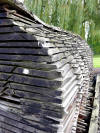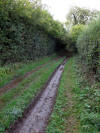

















Yorkshire, England 2015 - Walk to Kilburn
return to Yorkshire trip index
return to mdimage site index
On our first morning in Yorkshire, we slept in, had breakfast, and went for a walk.
The UK Ordnance Survey map indicated two, or possibly three, public access foot paths heading uphill to the tiny village of Kilburn, population 200, where the Mouseman furniture store & manufacturing center are located. The iconic White Horse of Kilburn can be seen on a hillside just above the village.
Being a Saturday, the furniture factory was closed but the sales room was open. We learned that 30 furniture makers work here, full-time. Mouseman furniture is made of exceptional quality English oak, and prices are high, for instance, a single oak napkin ring was 100 pounds, or $155 at the time.
Larger furniture pieces, like dining table & chairs cost 3,000 - 5,000 pounds, x 1.5 = lot of $$.
note - you can enlarge any part of a picture by left-clicking in and then out again.
note - the White Horse of Kilburn is 228 ft. high x 314 ft. wide, and is made of placed limestone; it is not a natural limestone outcropping, like many White Horses across the Country.
In 1857, a Kilburn school Headmaster and some of his students created the White Horse, and fresh limestone has been applied every 25 years or so since then.
Local furniture maker Robert "Mouseman" Thompson (1876-1955) lived & worked in Kilburn. The story is that his carved mice, part of every large furniture pieces, relates to the use of the phrase 'as poor as a church mouse', an idea that somehow inspired him. Thompson was part of the 1920's Arts & Crafts revival movement.
On our Yorkshire travels, we found this high-quality oak furniture in many different places, such as the tea shop at Byland Abbey, and, the Choir pews in York Minster.
Kilburn Church, shown above, built in the 1100s, was fully restored in 1869.
We found an old lane with well-established hedgerows on the walk back to Kilburn Park, which lane gradually narrowed into a walking trail. We saw new crops emerging from great-looking soil. The walking path terminated at the tiny road that is the driveway to our cottage, only a few minutes walk to the north.
So today we saw 2 of 3 trails between Kilburn & Kilburn Park, as shown on the Ordnance Survey (OS) Explorer map. On our last day in Yorkshire (in 13 days) I'll go in search of the third trail.
 |
a different way out of town |
 |
old muddy lane & hedgerows |
 |
October harvest |
 |
new crops emerging in October |
 |
farmers must keep an established trail open |
 |
|
 |
Cottage driveway |
 |
Holly & Nellie |
|
Eleven year old Holly was friendly and told us that her family, from Scotland, moved here recently after her father, upon retirement, purchased the only Pub in nearby Coxwold.
Holly's Dad bought Nellie for her, only a month before we arrived. Nellie is a trained show horse and can perform many tricks, Holly said. Nellie boards here so we saw Holly & Nellie many times during our two-week stay.
go to next page - Fountains Abbey
return to Yorkshire trip index
return to mdimage site index